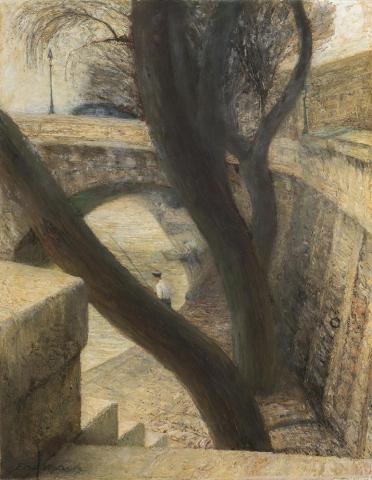BY THE SEINE, PARIS, c.1942 – 44
ERIC WILSON
oil on composition board
69.0 x 54.0 cm
signed lower left: Eric Wilson
bears inscription verso: ombak – Name – Eric Wilson / By the Seine Paris / 6 gns
Richard and Joan Crebbin Collection, Sydney
Mrs Joan Crebbin, Sydney
Eric Wilson, Newcastle Region Art Gallery, New South Wales, 29 July – 28 August 1983, cat. 34 (label attached verso) and travelling: Banyule Art Gallery, Victoria, 16 September – 16 October 1983; Queensland Art Gallery, Brisbane, 4 November – 4 December 1983 (illus. in exhibition catalogue, p. 43)
Eric Wilson, exhibition catalogue, Newcastle Region Art Gallery, New South Wales, 1983, cat. 34 (illus.), p. 43
By the Seine, c.1941 – 45, pen and ink and wash, 78.1 x 11.8 cm (sheet), inscribed in pencil on reverse ‘By the Seine / sketch for Painting / in Collection of / Sir Keith Murdoch’, National Gallery of Victoria, Melbourne
The bridges of Paris with their noble arches spanning the River Seine were a favourite subject for Eric Wilson, rivalled only by his streetscapes. By the Seine, Paris, 1939, c.1941 – 43 in a private collection competes with Rue de la Bonne, Montmarte, 1939, c.1941 – 42 in the collection of the Art Gallery of New South Wales, trumped only by the brilliant Scott Street, Glasgow, c.1942 secured by the National Gallery of Victoria, Melbourne through the Felton Bequest.1 Wilson won the New South Wales Travelling Art Scholarship in 1937, moving to England then France to study. He travelled and sketched in Belgium, the Netherlands and Italy, where he absorbed, among other things, that sense of touch and form so celebrated in the work of the Italian masters of the Quattrocento.2 The outbreak of the Second World War caused Wilson to return to Australia early, turning to his sketchbooks for numerous European subjects over the following years. Above all it was the scenes of Paris that inspired him most. ‘It was not the large-scale vistas of the master-planned metropolis that mattered most to him [wrote fellow artist Douglas Dundas], but the more intimate curves and corners of narrow streets, and the bridges and tree-lined quays of the Seine.’3 Our painting, By the Seine, Paris, c.1942 – 1944 is an example, magnificently composed and constructed, having been painted in Australia from detailed pen and pencil sketches recorded en plein air some years before. The painting follows the ink sketch very closely, the only significant addition being that of three fishermen. (The drawing is in the National Gallery of Victoria, previously being in the collection of Sir Keith Murdoch, who, in 1945, commissioned Wilson to paint a series of landscape on his property at Wantabadgery, on the Murrumbidgee River in New South Wales.)
By the Seine, Paris features a characteristic high view point looking down to the river’s embankment, seen in a number of related paintings, especially Seine, Paris, 1939 – 42 (once in the collection of Mrs Una Fraser) and Pont Neuf, c.1945 (Eric Wilson catalogue, op. cit., cat. 60, illus.). Fishermen were often added, as in Fisherman on the Seine (Leonard Joel, 7 November 1973, lot 254), giving the scenes a distinct human touch. The serpentine trunks of trees, as in our work, often dominate the foreground, the natural contrasted with the man-made curves of quays and the geometry of descending steps. Textures are lively, furthering the sense of tactility, and the atmosphere is all enveloping. The reflective mood evokes a breath of nostalgia, part of the attraction coming from the peeling back of objectivity to reveal a Paris before its wartime occupation.
1. Fine examples of Wilson’s landscapes were purchased by the Art Gallery of New South Wales, Sydney, Art Gallery of South Australia, Adelaide and the National Gallery of Victoria, Melbourne in 1942. Prominent private collectors included Sir Warwick Fairfax, Ronald Instone, Norman Schureck and Lloyd Rees.
2. See the sketch [Flight to Egypt, after Quattrocento composition], (1937) and related studies in the collection of the National Gallery of Australia, Canberra. The very gifted Wilson worked with equal success as a modern realist and a Cubist, Abstract – The Kitchen Stove, 1943 in the collection of the Art Gallery of New South Wales being a fine example of the latter.
3. Dundas, D., ‘Eric Wilson’, Art and Australia, vol. 12, no. 1, July – September Sydney, 1974, 56. Dundas described Wilson as ‘…one of the bright stars in the firmament of Australian art in the 1940s …’, p. 48
DAVID THOMAS
